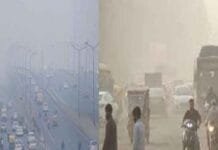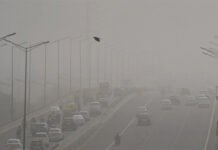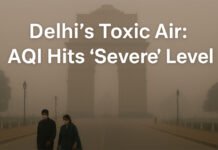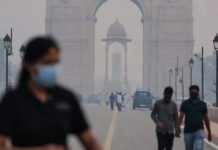As India moves past the recent festive season, air pollution continues to dominate headlines, particularly in northern cities. Delhi and Ludhiana are experiencing hazardous air quality levels, while Bengaluru enjoys notable improvement. Experts warn citizens to remain cautious, as festival-related emissions combined with seasonal weather patterns are causing spikes in particulate matter concentrations.
Delhi: Severe Pollution Persists
Delhi’s air quality index (AQI) remains at “severe” levels, with PM2.5 concentrations hovering around 147 µg/m³, significantly above the World Health Organization’s recommended safe limits of 25 µg/m³. The poor air quality is exacerbated by residual Diwali fireworks, low wind speeds, and cooler morning temperatures that trap pollutants near the ground.
“Residents should avoid outdoor activities during peak pollution hours, and masks such as N95 or FFP2 are highly recommended,” advises Dr. Anjali Mehta, an environmental health expert. Schools and healthcare authorities have issued warnings for children, elderly residents, and those with respiratory conditions.
Ludhiana: Diwali Hangover Impacts Lungs
In Punjab, Ludhiana is also struggling with hazardous air. PM2.5 levels have risen to around 235 µg/m³, prompting medical advisories for city residents. Local hospitals report an increase in cases of respiratory discomfort, asthma exacerbations, and eye irritation, indicating the acute impact of post-festival air pollution.
Experts attribute this spike to the combined effects of agricultural stubble burning, urban emissions, and lingering fireworks debris. “It’s a dangerous mix,” says environmental scientist Dr. Rakesh Chawla. “Northern cities need stricter regulation and immediate mitigation strategies to prevent long-term health impacts.”
Bengaluru: Improvement Provides a Breath of Relief
In contrast, Bengaluru’s air quality has shown significant improvement post-Diwali. The AQI fell to 83, representing a 44% reduction compared to last year’s festival season average of 120. The decline is credited to favorable wind patterns, effective city monitoring, and conscious efforts by residents to limit firecrackers.
City officials are optimistic that continued public awareness campaigns, combined with stricter emissions control, could help Bengaluru maintain better air quality in the coming months. “Community participation is key,” emphasizes Dr. Priya Nair, an environmental policy advisor. “When citizens take proactive steps, the difference is measurable.”
Health Advisory & Precautions
Given the mixed conditions across Indian cities, health authorities recommend:
Wearing high-quality air masks (N95/FFP2) outdoors in polluted zones.
Using indoor air purifiers to reduce particulate matter exposure.
Limiting strenuous outdoor activities, particularly in early mornings and evenings.
Monitoring daily AQI reports to plan commuting and school activities.
Government & Policy Response
India’s Central Pollution Control Board (CPCB) has urged states to enforce stricter emission standards, particularly during festival periods. Emergency measures, including temporary traffic restrictions and firecracker bans in sensitive zones, have been implemented in Delhi and Ludhiana to mitigate pollution peaks.
Experts recommend long-term strategies such as expanding green belts, promoting electric vehicles, and implementing smart urban planning to reduce citywide emissions. “Temporary measures are important, but sustainable urban development will define the air we breathe in the next decade,” explains urban environmentalist Sunil Verma.
Conclusion
October 24, 2025, highlights the stark contrast between cities battling hazardous pollution and those successfully improving air quality. While Delhi and Ludhiana struggle with festival and seasonal pollution, Bengaluru demonstrates that coordinated public and governmental action can produce tangible results.
As India prepares for upcoming festivals and winter months, citizens, policymakers, and environmental organizations must continue working together to reduce emissions, protect public health, and ensure cleaner skies for all.













